What We’re Reading: December 29th
Guest Editor: Dr Mike Page
 Mike is a postdoc at Lancaster University in the UK, and has been a Plantae Fellow since September 2017. He is a molecular biologist with a background in plant abiotic stress responses, including retrograde signaling pathways in which plastids manipulate nuclear gene expression. He is currently using synthetic biology to build the cyanobacterial carbon dioxide concentrating mechanism in rice plastids, with the ultimate aim of boosting photosynthesis and rice yields.
Mike is a postdoc at Lancaster University in the UK, and has been a Plantae Fellow since September 2017. He is a molecular biologist with a background in plant abiotic stress responses, including retrograde signaling pathways in which plastids manipulate nuclear gene expression. He is currently using synthetic biology to build the cyanobacterial carbon dioxide concentrating mechanism in rice plastids, with the ultimate aim of boosting photosynthesis and rice yields.
Review: Phytochrome, metabolism and growth plasticity
 Phytochromes are plant photoreceptors that can sense red and far-red light, as-well-as the ratio of these light qualities. This review examines the relationship between phytochrome signalling and carbon metabolism. Krahmer et al. assess the influence of phytochrome signalling on the synthesis of chlorophyll and carotenoids, the establishment of photosynthesis, the accumulation of photosynthetic proteins, primary carbon metabolism, physiology, and plant growth and biomass. The authors also address the role of the phytochrome system in sensing the endogenous carbon status of plants, as well-as how it intersects with retrograde signalling pathways. (Summary by Mike Page) Plant Physiol. 10.1104/pp.17.01437
Phytochromes are plant photoreceptors that can sense red and far-red light, as-well-as the ratio of these light qualities. This review examines the relationship between phytochrome signalling and carbon metabolism. Krahmer et al. assess the influence of phytochrome signalling on the synthesis of chlorophyll and carotenoids, the establishment of photosynthesis, the accumulation of photosynthetic proteins, primary carbon metabolism, physiology, and plant growth and biomass. The authors also address the role of the phytochrome system in sensing the endogenous carbon status of plants, as well-as how it intersects with retrograde signalling pathways. (Summary by Mike Page) Plant Physiol. 10.1104/pp.17.01437
The diversity of floral temperature patterns, and their use by pollinators
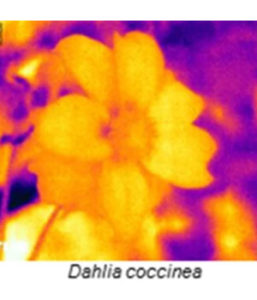 Bees and other pollinators experience the world in a different way to humans. They use different strategies in order to identify their surroundings, including their preferred flower species. Among these strategies, floral temperature. These differential “floral warming” happens due to floral thermogenesis or due to captured solar radiation. Harrap et al. report in their study the capacity of floral temperature patterns to function as a floral cue for bees, by taking thermographs of 118 plant species under good weather conditions. Of the tested plant species, 55% showed within-flower differences of more of 2°C, however some species had little to no detectable differences. In addition, Harrap et al. showed that bumblebees can learn, based solely on temperature patters, to distinguish rewarding from non-rewarding artificial flowers. These findings might be significant given the present climate change and temperature rising concerns. (Summary by Isabel Mendoza) eLIFE 10.7554/eLife.31262
Bees and other pollinators experience the world in a different way to humans. They use different strategies in order to identify their surroundings, including their preferred flower species. Among these strategies, floral temperature. These differential “floral warming” happens due to floral thermogenesis or due to captured solar radiation. Harrap et al. report in their study the capacity of floral temperature patterns to function as a floral cue for bees, by taking thermographs of 118 plant species under good weather conditions. Of the tested plant species, 55% showed within-flower differences of more of 2°C, however some species had little to no detectable differences. In addition, Harrap et al. showed that bumblebees can learn, based solely on temperature patters, to distinguish rewarding from non-rewarding artificial flowers. These findings might be significant given the present climate change and temperature rising concerns. (Summary by Isabel Mendoza) eLIFE 10.7554/eLife.31262
Synthetic hormone-responsive transcription factors can monitor an reprogram plant development
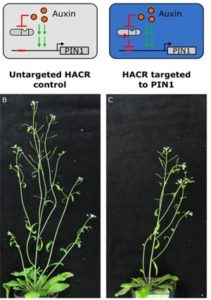 Development is driven by the activities of hormones which control expression of various traits. Modeling hormone pathways is complicated by extensive cross-talk, redundancy, and feedback loops. Khakhar et al. investigate the use of a technique known as Hormone Activated Cas9-based Repressors (HACRs) to alter specific hormone pathways in Arabidopsis. HACRs are modular in nature, allowing for insertion of a specific and inducible degradation target sequence. One such HACR tested had an auxin-inducible sequence which, in the presence of auxin, inhibits a downstream target responsible for repression of your gene of interest (GOI), allowing for activation of your GOI (i.e. fluorescent reporter). Two other variants were tested using the plant hormones jasmonate and gibberellin. All three HACRs were sensitive to their respective hormones, both endogenously and exogenously supplied, and were monitored in different tissues at varying developmental stages. Endogenous activation of HACRs resulted in predictable expression patterns. In a practical demonstration, the authors generated transgenic plants with a HACR targeting PIN1, presumably altering the threshold level of auxin required for PIN1 induction during lateral organ development. As hypothesized, these transgenic plants exhibited fewer co-initiating lateral organs. HACRs could be an efficient way to target single genes and reprogram developmental traits in many crop species. (Summary by Alecia Biel) BioRxiv 10.1101/236901
Development is driven by the activities of hormones which control expression of various traits. Modeling hormone pathways is complicated by extensive cross-talk, redundancy, and feedback loops. Khakhar et al. investigate the use of a technique known as Hormone Activated Cas9-based Repressors (HACRs) to alter specific hormone pathways in Arabidopsis. HACRs are modular in nature, allowing for insertion of a specific and inducible degradation target sequence. One such HACR tested had an auxin-inducible sequence which, in the presence of auxin, inhibits a downstream target responsible for repression of your gene of interest (GOI), allowing for activation of your GOI (i.e. fluorescent reporter). Two other variants were tested using the plant hormones jasmonate and gibberellin. All three HACRs were sensitive to their respective hormones, both endogenously and exogenously supplied, and were monitored in different tissues at varying developmental stages. Endogenous activation of HACRs resulted in predictable expression patterns. In a practical demonstration, the authors generated transgenic plants with a HACR targeting PIN1, presumably altering the threshold level of auxin required for PIN1 induction during lateral organ development. As hypothesized, these transgenic plants exhibited fewer co-initiating lateral organs. HACRs could be an efficient way to target single genes and reprogram developmental traits in many crop species. (Summary by Alecia Biel) BioRxiv 10.1101/236901
Arabidopsis calcium-dependent protein kinase AtCPK1 plays a positive role in salt/drought-stress response ($)
 Ca2+-dependent protein kinases (CPKs) can transfer calcium signals via phosphorylation events, a signaling process important for plant development and response to environmental stresses. With the multitude of CPKs thus far identified and their overlapping roles in both abiotic and biotic stress response, more information is needed to elucidate the roles of individual CPKs. Huang et al. focus on the role of AtCDPK1 in salt and drought stress. Arabidopsis cpk1 mutants were hypersensitive to salt stress while OE plants showed enhanced growth and survival under the same salt stress compared to WT plants. This trend was also seen in response to drought stress. Interestingly, cpk1 mutants had increased levels of H2O2 while OE plants had reduced H2O2 accumulation under both stresses. Furthermore, salt treatment also decreased the expression levels of several stress-inducible genes in the mutants, but these genes were increased in the OE lines. These data provide evidence for the role of AtCPK1 in positively regulating plant response to salinity and drought. (Summary by Alecia Biel) Biochem. Biophys. Res. Commun. 10.1016/j.bbrc.2017.11.175
Ca2+-dependent protein kinases (CPKs) can transfer calcium signals via phosphorylation events, a signaling process important for plant development and response to environmental stresses. With the multitude of CPKs thus far identified and their overlapping roles in both abiotic and biotic stress response, more information is needed to elucidate the roles of individual CPKs. Huang et al. focus on the role of AtCDPK1 in salt and drought stress. Arabidopsis cpk1 mutants were hypersensitive to salt stress while OE plants showed enhanced growth and survival under the same salt stress compared to WT plants. This trend was also seen in response to drought stress. Interestingly, cpk1 mutants had increased levels of H2O2 while OE plants had reduced H2O2 accumulation under both stresses. Furthermore, salt treatment also decreased the expression levels of several stress-inducible genes in the mutants, but these genes were increased in the OE lines. These data provide evidence for the role of AtCPK1 in positively regulating plant response to salinity and drought. (Summary by Alecia Biel) Biochem. Biophys. Res. Commun. 10.1016/j.bbrc.2017.11.175
APOPLASTP: prediction of effectors and plant proteins in the apoplast using machine learning ($)
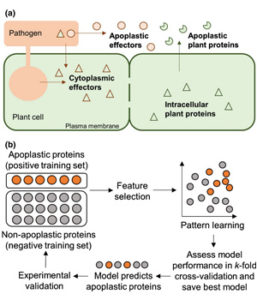 The apoplast represents a highly interactive site for intercellular communication and transport in plant-microbe interaction, that determines whether a pathogen can successfully overcome the early stages of plant defense. This site is also a battleground for an important class of apoplastic effectors that are known to perform exciting functions. Current methods of predicted apoplastic proteins are limited to microscopy and apoplastic proteomics which pose technical challenges. However, computational methods to predict the apoplastic proteins don’t exist. Sperschneider et al. have presented a machine learning platform called ApoplastP that predicts whether an effector or plant protein localizes to the apoplast. ApoplastP is based on common features of depletion in glutamic acid, and acidic/ charged amino acids. It has been validated by using numerous fungal effectors from the database and shows an accuracy of 75% with a false positive rate of 5%. Hence ApoplastP has started a pioneer computational method for predicting proteins with apoplastic localization and hence will promote functional studies on effectors and plant proteins in apoplastic space thereby understanding their role more rapidly. (Summary by Amey Redkar) New Phytol. 10.1111/nph.14946
The apoplast represents a highly interactive site for intercellular communication and transport in plant-microbe interaction, that determines whether a pathogen can successfully overcome the early stages of plant defense. This site is also a battleground for an important class of apoplastic effectors that are known to perform exciting functions. Current methods of predicted apoplastic proteins are limited to microscopy and apoplastic proteomics which pose technical challenges. However, computational methods to predict the apoplastic proteins don’t exist. Sperschneider et al. have presented a machine learning platform called ApoplastP that predicts whether an effector or plant protein localizes to the apoplast. ApoplastP is based on common features of depletion in glutamic acid, and acidic/ charged amino acids. It has been validated by using numerous fungal effectors from the database and shows an accuracy of 75% with a false positive rate of 5%. Hence ApoplastP has started a pioneer computational method for predicting proteins with apoplastic localization and hence will promote functional studies on effectors and plant proteins in apoplastic space thereby understanding their role more rapidly. (Summary by Amey Redkar) New Phytol. 10.1111/nph.14946
Verification of Arabidopsis stock collections using SNPmatch, a tool for genotyping high-plexed samples
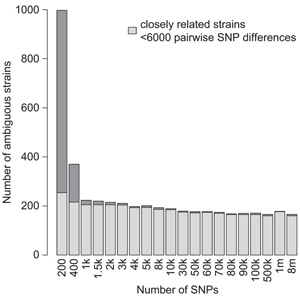 Experiments using large germplasm collections are prone to contamination. With dropping sequencing costs, it becomes easier to validate the genotype using minimal sequencing coverage. Pisupati and colleagues developed an open-source python pipeline, called SNPmatch, allowing identification of 930 Arabidopsis accessions from 1001 Genomes panel, based on 2,000 SNPs obtained by sequencing with minimal genome coverage. Differentiating between more closely related strains, differing by less than 6,000 SNPs, higher coverage was required. 74 mismatched lines were identified in 1001 Genomes panel. The user-friendly AraGeno web-application can be used by anyone to validate their own Arabidopsis stocks. The pipeline can be used on transcriptome or bisulfite sequencing data and has a potential to be extended to other plant species, allowing for quick and easy validation of germplasm. (Summary by Magdalena Julkowska) Sci. Data 10.1038/sdata.2017.184
Experiments using large germplasm collections are prone to contamination. With dropping sequencing costs, it becomes easier to validate the genotype using minimal sequencing coverage. Pisupati and colleagues developed an open-source python pipeline, called SNPmatch, allowing identification of 930 Arabidopsis accessions from 1001 Genomes panel, based on 2,000 SNPs obtained by sequencing with minimal genome coverage. Differentiating between more closely related strains, differing by less than 6,000 SNPs, higher coverage was required. 74 mismatched lines were identified in 1001 Genomes panel. The user-friendly AraGeno web-application can be used by anyone to validate their own Arabidopsis stocks. The pipeline can be used on transcriptome or bisulfite sequencing data and has a potential to be extended to other plant species, allowing for quick and easy validation of germplasm. (Summary by Magdalena Julkowska) Sci. Data 10.1038/sdata.2017.184
Stochastic gene expression in Arabidopsis thaliana
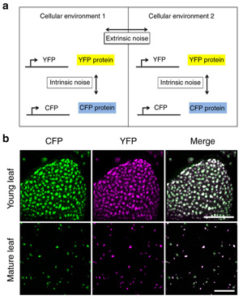 Biology is a noisy act, as the expression of the same gene in the cells of the same tissue differs. This noise can be divided into intrinsic noise, due to inherent stochasticity of molecular processes, and extrinsic noise, indicating differences between the neighboring cells. Schultheiß Araújo and colleagues used NLS-YFP / -CFP driven by 35S and UBQ10 promoters and observed variability in expression of fluorophores throughout the time and space. The levels of extrinsic noise were observed to be higher than intrinsic noise. Extrinsic noise increased among the cells with higher endoreduplication levels. The correlation of the extrinsic noise between the neighboring cells was observed only in young tissues. This spatial coupling was found to depend on inheritance of mRNA, protein content and other rates related to gene expression, suggesting existence of micro-domains differing in physiological properties. (Summary by Magdalena Julkowska) Nat. Commun. 10.1038/s41467-017-02285-7
Biology is a noisy act, as the expression of the same gene in the cells of the same tissue differs. This noise can be divided into intrinsic noise, due to inherent stochasticity of molecular processes, and extrinsic noise, indicating differences between the neighboring cells. Schultheiß Araújo and colleagues used NLS-YFP / -CFP driven by 35S and UBQ10 promoters and observed variability in expression of fluorophores throughout the time and space. The levels of extrinsic noise were observed to be higher than intrinsic noise. Extrinsic noise increased among the cells with higher endoreduplication levels. The correlation of the extrinsic noise between the neighboring cells was observed only in young tissues. This spatial coupling was found to depend on inheritance of mRNA, protein content and other rates related to gene expression, suggesting existence of micro-domains differing in physiological properties. (Summary by Magdalena Julkowska) Nat. Commun. 10.1038/s41467-017-02285-7



